Recent Posts
- Get HOMICIDE in four editions. Rated No.1 among The Five Best Crimes Biographies of All Time
- HOMICIDE AT ROUGH POINT, the true crime story launched in Vanity Fair on how billionairess Doris Duke killed designer Eduardo Tirella outside the gates of her Newport, RI estate and got away with murder
- Peter Lance Biography
- HuffPost: DOJ report on MISSBURN case leaves out key detail: I.D. of the Mafia killer who broke the case for Hoover’s FBI
- With President Trump’s order to release files on JFK’s death, consider my 1983 ABC NEWS report on public concerns back then that The Feds were hiding the truth
Archives
- March 2025
- February 2025
- January 2025
- December 2024
- November 2024
- October 2024
- July 2024
- June 2024
- March 2024
- February 2024
- January 2024
- November 2023
- June 2023
- April 2023
- March 2023
- February 2023
- December 2022
- August 2022
- July 2022
- March 2022
- February 2022
- January 2022
- December 2021
- August 2020
- July 2020
- June 2020
- February 2020
- January 2020
- November 2019
- September 2019
- April 2019
- February 2018
- January 2018
- December 2017
- November 2017
- September 2017
- June 2017
- April 2017
- February 2017
- January 2017
- December 2016
- November 2016
- October 2016
- September 2016
- August 2016
- July 2016
- June 2016
- May 2016
- April 2016
- March 2016
- February 2016
- January 2016
- December 2015
- November 2015
- October 2015
- September 2015
- August 2015
- July 2015
- June 2015
- May 2015
- March 2015
- February 2015
- January 2015
- December 2014
- November 2014
- July 2014
- June 2014
- May 2014
- April 2014
- March 2014
- January 2014
- December 2013
- November 2013
- October 2013
- September 2013
- August 2013
- July 2013
- June 2013
- May 2013
- April 2013
- March 2013
- February 2013
- January 2013
- December 2012
- November 2012
- October 2012
- September 2012
- August 2012
- July 2012
- June 2012
- May 2012
- April 2012
- January 2012
- December 2011
- June 2011
- April 2011
- March 2011
- February 2011
- January 2011
- November 2010
- October 2010
- March 2010
- August 2009
- November 2006
- November 2004
- October 2003
- September 2003
- February 2000
Categories
- 1000 Years for Revenge
- ABC's Path to 9/11 issue
- Ali Mohamed
- Ali Mohamed revelations
- Anwar al-Awlaki
- ARCHIVES
- awards
- bio
- BIOGRAPHY
- BOOK TV C-SPAN2
- BOOK WRITING
- BOOKS
- Colombo family "war"
- Commentary
- DUI investigation
- Emad Salem investigation
- FBI ORGANIZED CRIME
- Featured
- FICTION
- First Degree Burn
- Fitzgerald censorship attempt
- Fitzgerald censorship scandal
- Fox News
- Gotham City Insider
- Gregory Scarpa Jr.
- Gregory Scarpa Jr.
- Gregory Scarpa Sr.
- Harpercollins
- HUFFINGTON POST
- INVESTIGATIONS
- Khalid Shaikh Mohammed
- MAGAZINE ARTICLES
- Major Hasan Fort Hood massacre
- MEDIA COVERAGE
- Meier Kahane Assassination
- Meir Kahane assassination
- Murder Inc.
- Nat Geo whitewash
- NEWSPAPER REPORTING
- NOVELS
- Oklahoma City bombing
- Omar Abdel Rahman
- OPERATION ABLE DANGER
- POLICE CORRUPTION
- Produced
- R. Lindley DeVecchio
- Ramzi Yousef
- Ramzi Yousef sting 302's
- REPORTING & ANALYSIS
- RESEARCH
- Santa Barbara News-Press
- SCREENWRITING
- Stranger 456
- Stranger 456
- teleplays
- Tenacity Media
- Triple Cross
- Triple Cross
- TV NEWS COMMENTARY
- Uncategorized
- videos
- WIKIPEDIA
Former NYT reporter Nicholas Gage, the dean of O.C. journalists, calls DEAL WITH THE DEVIL, “the most penetrating look into the inner workings of the Mafia since ‘The Valachi Papers.'”
ORDER SIGNED FIRST EDITIONS or copies from amazon.com
INTRODUCTION By Peter Lance
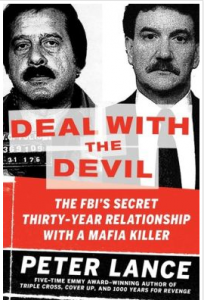
Five foot ten, two hundred and twenty pounds, Scarpa was described by one of his FBI contacting agents as “an ox of a man; like a short piano mover [with a] thick neck and huge biceps.” For more than forty-two years, as capo of the Colombo family or “borgata,” he roamed the streets of Brooklyn like a feudal lord, earning the nicknames “The Grim Reaper,” “The Mad Hatter,” ‘”Hannibal Lecter,” and “The Killing Machine.” He even signed personal letters with the initials “KM.”
But Scarpa was also a homebody with three separate families. In 1949 he married the former Connie Forrest; they had four children, including Gregory Jr., who started doing crimes for his father at sixteen. Then, while still married to Connie, whom he shipped off to New Jersey, Scarpa moved in with Linda Diana, a gorgeous brunette nineteen years younger, who had been dating wiseguys since her mid-teens. Scarpa had two children with Linda, but in an effort to hide the fact that they were Greg’s, she married a man named Schiro, who believed the kids were his own.
Then, while still married to Forrest and living as Linda’s common-law husband, in 1975 Scarpa ran off to Las Vegas and married Lili Dajani, a former Miss Israel. Years later, Dajani’s lover, a former abortion doctor named Eli Shkolnik, was murdered on Scarpa’s orders. Yet in 1979 Scarpa agreed to let Linda carry on a torrid sexual relationship with Larry Mazza, a handsome eighteen-year-old delivery boy—and later made Mazza his protégé, schooling him in loan sharking, bank robbery, and homicide.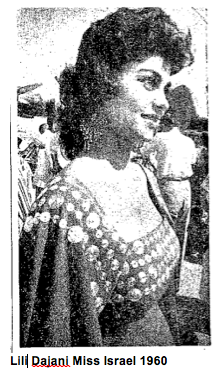
“I started out one way and ended up with the devil,” Mazza later said. The ex-grocery worker expressed shock when Scarpa Sr. once suggested to him that they kill the mother of a mob turncoat in order to demonstrate “what happens to rats.”
Still, Scarpa, who bragged that he “loved the smell of gunpowder,” had no compunctions about killing women. When he heard that Mary Bari, the beautiful mistress of the family underboss, might talk to authorities, he had her lured to a club, then shot her in the head point blank and dumped her body in a rolled-up canvas two miles away. Later, when the dog of one of his crew members’ wives found a piece of the dead woman’s ear, Scarpa joked about it over dinner. “He was just a vicious, violent animal,” said Mazza. “Unscrupulous and treacherous . . . just a horrible human being.” 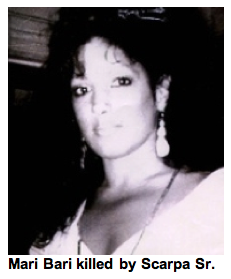
And yet Scarpa’s daughter, “Little Linda” Schiro, described him as “incredibly loving—the kind of dad who was there for us every night for dinner at five o’clock. Whatever he was on the outside, he was really gentle at home.” Like a true sociopath, Scarpa was apparently capable of shifting at will from brutal murderer to loyal dad. After one bloody rubout, when Mazza and Scarpa shot a rival in the head, they went home to play with Greg’s infant grandson, drink wine, and watch Seinfeld on TV.
“He could transform himself,” says Little Linda. “He could go kill someone and five minutes later he’d be home watching Wheel of Fortune with my brother and me.” The Grim Reaper ruled 13th Avenue in Bensonhurst with an iron fist. He was responsible for twenty-five separate homicides between 1980 and 1992. With Mazza’s help, Scarpa killed three people in one four-week period. He shot one of his victims with a rifle while he was stringing Christmas lights with his wife. He killed a seventy-eight-year-old member of the Genovese family because the old man happened to be in the wrong place at the wrong time.
Then, a few weeks later, after FBI and NYPD surveillance had been pulled away from a Mafia social club, he rolled up next to Colombo capo Nicholas Grancio and ordered him shot with a rifle. Grancio’s nose was blown off and one of his teeth was later found in a nearby building; as Mazza pulled the trigger, Scarpa growled, “This one’s for Carmine,” a declaration of vengeance that could have come from a B-movie. At another point, tipped that Cosmo Catanzano, one of his crew members, might talk to the Feds, Scarpa Sr. ordered his grave dug in advance of the murder, but Catanzano escaped when DEA agents arrested him before the execution could take place. 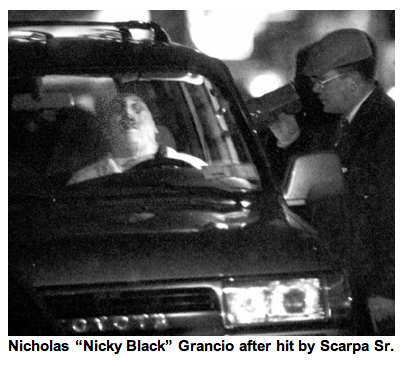
“The man was the master of the unpredictable and he knew absolutely no bounds of fear,” said Joseph Benfante, one of Scarpa’s former lawyers. “If he’d lived four hundred years ago, he would have been a pirate.”
The brazen Scarpa even gave himself a reason to wear an eye patch. In 1992, after being diagnosed with the HIV virus and given only months to live, he broke house arrest and went after a pair of local drug dealers who had threatened his younger son. In the ensuing gun battle, Scarpa got his right eye shot out, but he walked home and downed a glass of scotch before Larry Mazza was summoned and drove him to the hospital.
“Scarpa had an action jones,” one former assistant district attorney recalled Another investigator described the killer’s need to stay on the edge: “Capos ain’t supposed to be out on the street hijacking trucks, doing drug deals,” he said. “I mean, that’s why you have a crew. But Greg was there. He always had to walk point.” And yet, even as he openly disparaged “rats,” Scarpa devoted more than three decades off and on to betraying his larger “family,” the Colombos.
THE SECRET FILES
The 1,153 pages of files uncovered in this investigation reveal that more than two years before celebrated Mafia turncoat Joseph Valachi “sang” to the McClellan “rackets” committee in an historic series of hearings televised from coast to coast, Scarpa Sr. was already coughing up the family’s most intimate secrets to the FBI.
The detailed multi-page memos called Airtels (later designated as FBI 209 Forms) show that Scarpa Sr., whose code designation was NY3461, met two or three times a month with agents from the FBI’s New York Office. During these secret sessions conducted in hotel rooms, automobiles and Senior’s various homes in Brooklyn, he fed them the kind of inside-the-family dirt that J. Edgar Hoover craved. Every one of those Airtels went straight to the Director himself and as we’ll see, while many of the debriefings contained detailed intelligence on the organizational structure of the Mafia, “34,” as he was known, also gave the Bureau reams of disinformation. 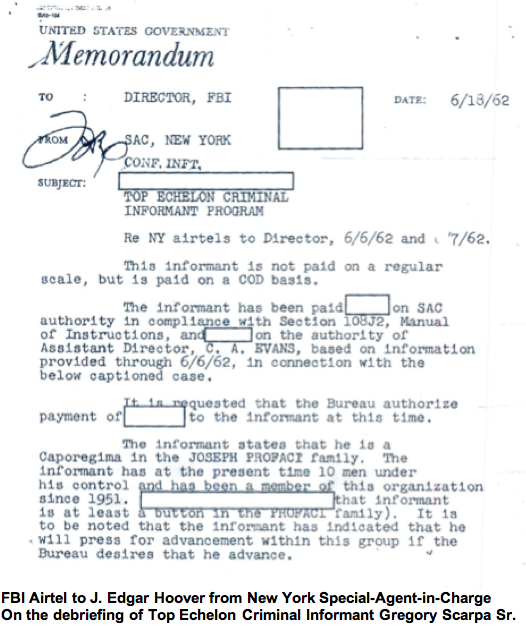
A brilliant Machiavellian strategist, Scarpa Sr. not only stayed on the street for forty-two years, avoiding prison after fourteen separate arrests and indictments for his crimes, but he repeatedly “ratted out” his competition in the family – literally eliminating many of the capos above him along with the two family bosses: Joseph Colombo and Carmine Persico. He also succeeded in fomenting a series of internal conflicts or wars that tore the borgata apart.
It was Scarpa whose duplicity paved the way for the notorious assassination attempt on Joseph Colombo at an Italian American Civil Rights League Rally in front of 50,000 people in 1971. It was Scarpa whose back door machinations ignited the second Colombo war between wiseguys loyal to Persico and the violent Gallo brothers in the early 1970’s and it was Scarpa who fueled the battle that led to the infamous rubout of Crazy Joe Gallo in 1972. Most important to the Feds, it was Scarpa who provided the probable cause that led to the Title III wiretaps in the historic Mafia Commission case in the mid 1980’s sending Persico and two other New York bosses to prison for life.
1989, Everett Hatcher, a decorated DEA agent, was gunned down by Scarpa’s nephew Gus Farace, who was a member of Greg’s Wimpy Boy’s crew. That cold-blooded shooting led to the formation of a five-hundred-man FBI/DEA task force and an international manhunt that lasted more than nine months. New evidence now suggests that it was Scarpa who set up his own nephew’s murder to take the heat off the other New York families.
Scarpa was such a master chess player that he used his position as a Top Echelon informant to earn hundreds of thousands of dollars, beyond the millions he made from racketeering. Not only did the FBI pay him $158,000 in fees and bonuses for his services, but his control agent from the mid-1960s to the early ’70s, Anthony Villano, brokered kickbacks from insurance companies for some of the high-end hijackings Scarpa was executing. Those “rewards,” amounting to tens of thousands of dollars, went back to Scarpa for his own thefts of “swag” ranging from liquor to negotiable stocks to gold bullion, jewelry, and uranium.
Scarpa even got a cut of a reward for the return of the Regina Pacis jewels after a gang of junkies stole the coveted items from a Brooklyn church. That led to national headlines for the Bureau after Villano negotiated the recovery. 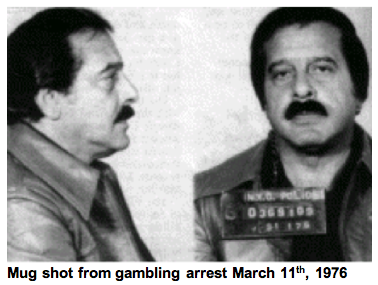
“The Killing Machine” also worked for the Government in a series of “black bag jobs” that he performed off the books. The first was his well known trip to Mississippi in the summer of 1964 when he tortured a Ku Klux Klan member in order to solve the mystery of the MISSBURN case – locating the bodies of slain civil rights workers Goodman, Schwerner & Chaney when FBI agents assigned to the probe came up empty.
After breaking a second civil rights murder in 1966 as an FBI “special” asset, Scarpa traveled to Costa Rica in the early 1980s to extradite fugitive Colombo capo Anthony Peraino, the notorious porn king who had made millions from the production of the film Deep Throat.
In return for his assistance to the Feds, Scarpa collected in spades, using his influence with the FBI to avoid prosecution on three separate indictments by organized crime Strike Forces over the years. Not only did he beat a 1974 indictment for stealing more than $4 million in counterfeit IBM stock, but when Secret Service agents arrested him in 1986 for credit card fraud, on charges that could have led to seven years in prison and a $250,000 fine, the FBI intervened and helped him get his sentence reduced to probation and a $10,000 fine.
By that time, Scarpa had been infected with HIV after a tainted blood transfusion and was given only months to live. At least that’s what the government told the sentencing judge. If he’d gone to prison then, Scarpa would never have been on the street to foment his last great conspiracy: the third Colombo war. But he lived for another six years.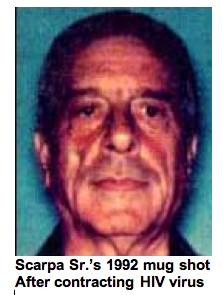
The man who vouched for him during the time was Roy Lindley DeVecchio, known in the Bureau as “Mr. Organized Crime” for his purported success putting wiseguys away. After officially reopening Scarpa in 1980 following a five-year hiatus, Lin, as he was known, quickly rose through the Bureau ranks, commanding two organized crime squads. He also taught informant development at the FBI Academy and became supervising case agent on the Mafia Commission case, due in large part to his “management” of Informant 3461 aka “34.”
But defense attorneys would later describe Lin’s relationship with Scarpa as an “unholy alliance.” In 1994, the FBI opened an OPR internal affairs investigation after four agents under DeVecchio effectively accused him of leaking key intelligence to the mad dog killer. DeVecchio who refused to take a polygraph test, was nevertheless granted immunity during the probe, making it virtually impossible for the Justice Department to indict him. In 1996, he retired with a full pension. Later, he was granted immunity a second time, but he answered “I don’t recall,” or words to that effect, more than fifty times at a 1997 hearing as defense lawyers tried to peel back the layers on his clandestine dealings with Scarpa.
In March 2006, the Brooklyn district attorney unsealed an indictment charging Lin DeVecchio with four counts of murder stemming from his twelve-year relationship with Gregory Scarpa, Sr. The following year, after an aborted two-week trial, those charges were dismissed. But not before Scarpa’s protégé Larry Mazza testified that his homicidal mentor had “stopped counting” after fifty executions. “It was like growing up with a serial killer,” said his own daughter, “Little Linda” Schiro.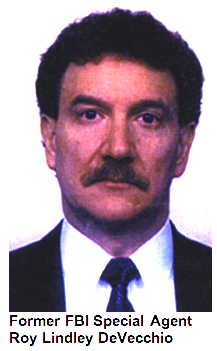
Scarpa’s most violent period came during that third Colombo war, which he incited. The death toll during that conflict was fourteen, with Scarpa personally responsible for at least six of the hits. And each time he executed a significant rubout Scarpa would punch the satanic digits 6-6-6 into the pager of his consigliere to let him know that the job was done.
Along with a final murder he committed four days after Christmas in 1992, that brought the number of homicide he’d ordered or executed on Lin DeVecchio’s watch to twenty-five. That figure amounted to half the murders Mazza says Scarpa committed before he quit keeping track. (Mazza later reaffirmed the number in a 2012 interview with the New York Post.)
Those fifty homicides made the Grim Reaper perhaps the most prolific hit man in the history of organized crime, and put him in the ranks of the world’s top serial killers. The fact that most of those deaths occurred while he was being paid as a virtual agent provocateur by the Feds is a testament to the FBI’s willingness to make “a deal with the devil,” as DeVecchio’s trial judge put it.
THIRTY DAYS IN FORTY-TWO YEARS
In more than four decades as a violent gangster, Gregory Scarpa, Sr., served only thirty days in jail—and that was during the years when he was “closed” as an FBI source. The rest of that time, a series of FBI agents intervened to keep the so-called Mad Hatter on the street. But that wasn’t the most disturbing aspect of Scarpa’s relationship with the government. In light of the 1,150-plus pages of FBI files on Scarpa we’ve accessed, it can be fairly argued that the FBI’s very playbook against La Cosa Nostra was defined and shaped by what Scarpa fed them—particularly in the years from 1961 to 1972, when J. Edgar Hoover himself was on the receiving end of 34’s Airtels.
Given the Bureau’s relationship with Scarpa, it’s no surprise that a senior federal judge sentenced one minor Colombo capo convicted in 1992 to multiple life terms for crimes far less repugnant than Scarpa’s.” But Scarpa’s own final sentence, from the same judge, amounted to a legal wrist slap.
 Even as he was being ravaged by the HIV virus—shrinking from 220 pounds to an emaciated 116 toward the end of his life—Scarpa beat the real grim reaper by many years, staying alive to commit multiple homicides as he schemed to take over the family in the phony war he’d engineered. Few figures in the annals of organized crime have operated with such tenacity, deviousness, and reckless disregard for human life. The fact that he served as the FBI’s secret weapon against what Lin DeVecchio calls “the Mafia enemy,” only underscores the moral ambiguity that runs through this story.
Even as he was being ravaged by the HIV virus—shrinking from 220 pounds to an emaciated 116 toward the end of his life—Scarpa beat the real grim reaper by many years, staying alive to commit multiple homicides as he schemed to take over the family in the phony war he’d engineered. Few figures in the annals of organized crime have operated with such tenacity, deviousness, and reckless disregard for human life. The fact that he served as the FBI’s secret weapon against what Lin DeVecchio calls “the Mafia enemy,” only underscores the moral ambiguity that runs through this story.
Drawing on secret FBI Airtels never before seen outside the Bureau, in the pages ahead we’ll reveal how Gregory Scarpa, Sr., then a young capo for the Profaci crime family, led J. Edgar Hoover himself into the inner sanctum of the underworld Once that alliance began, there seemed to be no turning back for the Bureau. “They enlisted a hyper-violent killer to stop much less capable murderers,” says defense lawyer Ellen Resnick, whose work helped expose this unholy alliance. “It was the ultimate ends-justify-the-means relationship.”
As you turn the pages of this book, there are two crucial questions to keep in mind: Who was in charge: the special agents like Tony Villano and Lin DeVecchio, who were responsible for “controlling” Scarpa, or the killer himself? And who got the most out of this deal with the devil: the FBI or the very “Mafia enemy” they sought to defeat ?



Recent Comments